Round The World and other travels
A frequent flyer's collection of trip diaries
This is: A Taste of the Deep South (2013)
In-depth historic Savannah
Today would be dedicated to strolling historic Savannah, minus some of the weekend tourist hordes. As the new working week got underway, breakfast was very much quieter and we managed a nice early start.
We began by heading eastwards on our very own West Harris Street, continuing past Pulaski Square and the beautiful Green-Meldrum House to Madison Square. Named for the nation’s fourth president, the square is actually a memorial to Sergeant William Jasper, an Irish immigrant killed leading the American charge during the first Siege of Savannah when the Americans failed to take control of the city from the British. He is not buried in the square, but in a mass grave near the battlefield, along with other soldier-immigrants. The two small cannons in the square have nothing to do with the siege, but rather commemorate the first two highways in Georgia, Augusta Road and Ogeechee Road. We were rapidly becoming familiar with the elegant squares with their giant oak and cypress trees and with the beautiful architecture featuring raised basements and balconies, but we certainly weren't in any danger of taking any of it for granted.
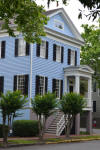 |
 |
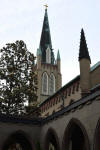 |
 |
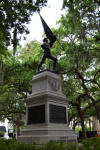 |
||
 |
 |
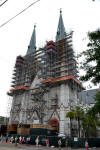 |
 |
 |
 |
ABOVE and LEFT: Savannah's Roman Catholic cathedral, with external restoration work in progress |
Continuing east a couple of blocks, West Harris Street became East Harris Street as we crossed Drayton Street, and brought us to Lafayette Square and the Cathedral of St. John the Baptist, spiritual home of Savannah’s Irish descendants and the oldest Catholic church in the state. The original sanctuary was built in 1873 by Haitian immigrants and known as Our Lady of Perpetual Help, but it burned down in 1898 leaving only the two spires. It was rebuilt in its current form in a mere 18 months. Given the effect of restoration works on the building's external appearance at the time of our visit, nothing prepared me for the cathedral's sumptuous interior, which contained magnificent stained glass windows from Austria, woodcarvings from Bavaria, and an altar and baptismal font made from Italian marble. The latter was a particularly fine feature, with a prominent Celtic knot pattern and constantly flowing water. In 2003 an armed man entered the cathedral and set fire to the original pulpit and Bishop’s chair, in a protest against organised religion that caused over $400,000 worth of damage. The one that we saw was an exact replica carved in Italy.
 |
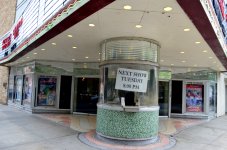 |
After viewing the cathedral, we walked north on Abercorn Street and west on W Hull Street until we came to the historic Savannah Theatre on the northeast corner of Chippewa Square. Opened in 1818, it’s the oldest continuously operating theatre in the USA and the stage has been occupied by notables such as Edwin Booth (brother of President Lincoln’s assassin), W.C. Fields and Oscar Wilde. A fire in 1948 destroyed much of the original design, but the theatre still hosts productions.
 |
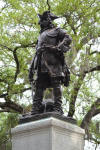 |
 |
 |
 |
|
| ABOVE: Highlights of Chippewa Square, including morning coffee! | ||
We took a quick look at Chippewa Square, named for a battle in the war of 1812, with a large monument to General James Edward Oglethorpe who was sent on a mission by King George II to buffer Charleston from the Spanish. Oglethorpe was a true visionary for his time, with progressive ideas such as banning slavery and hard liquor, although those two quickly fell by the wayside when the realities of Savannah as a seaport were realised. He was responsible for laying out Savannah in a deceptively simple plan of a grid system interlinking beautiful squares, and he is still studied to this day as a master of near perfect urban design. The north side of the square is the location where Forrest Gump sat on the bench twice in the movie speaking about chocolates and such. Looking south from here, we saw the infamous Drayton Tower, the controversial 1955 “internationalist style” high-rise loathed by traditionalists to this day. Once reserved for rundown student housing, the tower is now subdivided into pricey condos and retail spaces. As we were so far ahead of schedule at this point, we decided to treat ourselves to mid-morning coffee at local coffee shop Gallery Espresso.
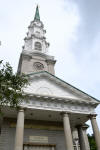 |
 |
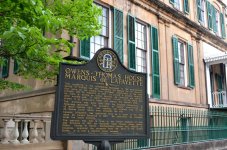 |
 |
We continued north up Bull Street from Chippewa Square, passing on our left the Independent Presbyterian Church founded in 1755 for colonial adherents of the Church of Scotland, and on our right the Juliette Gordon Low birthplace. Juliette Gordon Low was a true pioneer for women who travelled extensively after school, and founded the Girl Scouts of America in 1912 after meeting Robert Baden-Powell, founder of the Boy Scouts and Girl Guides in England. We continued up Bull Street another couple of blocks to Wright Square, with its impressive Lutheran Church of the Ascension. Two blocks east of here we came to Oglethorpe Square, which funnily enough is not home to the namesake statue - we had of course already seen it in Chippewa Square! When we stopped outside the Owens-Thomas House, one of the day's intended highlights and one that we definitely wanted to tour, it became instantly apparent just how far we had drifted from the plan. Despite the earlier coffee stop, we were so far ahead of schedule that the house hadn't even opened its doors for the day.
 |
| ... and Bob's your uncle! |
The only sensible option at this point was to re-schedule the Owens-Thomas house for later in the day, abandon our intended lunch stop for the second day in succession and press on towards the river. We reached our revised objective at Morrell Park, home to the well-known statue of Florence Martus (a.k.a. The Waving Girl) who legend says welcomed ships by lantern from her lonely balcony, looking for her love who was long lost at sea. The truth is that she was a life-long spinster who lived with her brother, the lighthouse keeper, and when he died she whiled away the hours greeting vessels along the river from her balcony. As the River Street streetcar only ran from Friday afternoons through the weekend, we walked the whole length of the riverfront in the blazing late-morning / midday sun. As expected, there was a strong whiff of Touristville Central about it. Revising the plan for a 4pm river cruise, we bought tickets for the 2pm sailing instead.
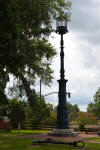 |
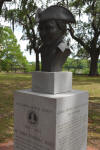 |
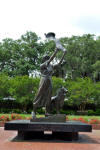 |
 |
 |
 |
 |
 |
 |
 |
 |
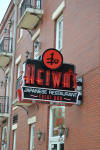 |
 |
 |
Still having plenty of time in hand, we climbed up to the City Market / Ellis Square area with the help of a public elevator. We had time for a quick look around and in the process spotted the restaurant where we held a reservation for dinner much later in the day. The hunt soon began for an appropriate replacement lunch stop and we settled on Heiwa's, a Japanese restaurant serving sushi. It was a nice, light choice after the previous day's fried food and pizza.

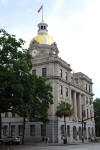 |
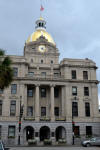 |
 |
 |
We then had some time for a brief wander in the area around City Hall, during which time it started to rain, before returning to the riverbank below in good time to board our cruise.
The cruise proved to be relaxing way to spend an hour after all our exertions earlier in the day and, as expected, offered a different perspective of this city that was by now starting to feel familiar. The rain cleared up during the sailing and this helped considerably.
 |
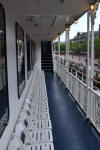 |
 |
 |
 |
 |
 |
 |
 |
 |
 |
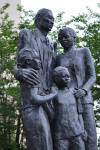 |
 |
 |
Safely returned to dry - well, almost! - land, we set about putting right the main piece of unfinished business from earlier in the day: we needed to return to the Owens-Thomas house on Oglethorpe Square, and did so via Johnson Square. Much of the walk took place in a heavy downpour, but we still managed to see the Maya Angelou slavery memorial, Christ Church and the Lucas Theatre.
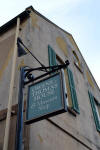 |
 |
 |
 |
 |
Having reached our objective, we were fortunate in being able to join a guided tour that was due to leave within five minutes. The building is widely known as the finest example of Regency architecture in the United States. It was designed by Englishman William Jay, one of the first professionally trained architects in the country, and only 24 years old when he designed the home. The tour proved to be the best - so far, at any rate - of the trip and gave a fascinating insight into little touches like curved walls with doors bowed to match, and recessed skylights. The complex plumbing system featured rain-fed cisterns, flushing toilets, sinks, bathtubs and showers, and this was the first house in Savannah to feature indoor plumbing. On the south-side verandah, Revolutionary War hero the Marquis de Lafayette addressed Savannahians during his visit in 1825.
 |
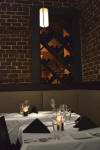 |
 |
The sight-seeing programme now complete, we wandered back to the hotel, where there was time to relax and freshen up before heading back out to mark our last night in Savannah with a blowout dinner at the oddly named a.lure, a fine-dining restaurant on West Congress Street celebrating contemporary low-country cuisine. My starter was billed as a Ceviche Martini and I went on to enjoy the 'special' main course of scallops and tropical fruit paella. Bruce kicked off with cornmeal-dusted chicken livers, followed by pan-fried red snapper over Soba noodles, with a Shiitake-Dashi broth. All this was washed down with an excellent bottle of wine.
It proved to be a superb experience: great dinner, beautiful surroundings and intelligent, attentive service from our young waiter. What a fitting way to bring to a close our short stay in this friendly and likeable city!